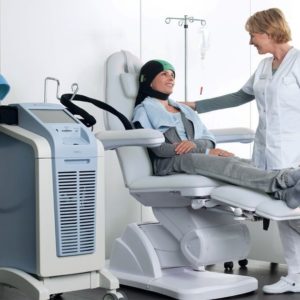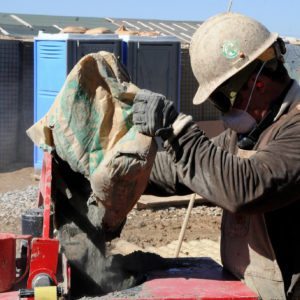Epithelioid Mesothelioma

Epithelioid mesothelioma is a form of the asbestos cancer that develops in the epithelial cells. It is the most common type of mesothelioma, making up about 70 percent of all mesothelioma cases. Because epithelioid mesothelioma does not spread as quickly as cancer involving the other two cell types (sarcomatoid and biphasic), it is also the most treatable form of the disease.
Characteristics of Epithelioid Mesothelioma
Epithelial tissue lines the whole human body, including all internal and external organs. The tissue is made up of cells that stick very close together, forming sheets. The sheet layers are avascular (without blood vessels) but innervated (containing a nerve supply).
Epithelial tissue cells are polarized, attaching to each other and to a basement membrane of underlying tissue that helps cement the tissue to the bodily structures it is protecting, whether external or internal.
When a person inhales or ingests microscopic asbestos fibers, the fibers can stick in the epithelial tissue, eventually leading to cell mutation and resulting in mesothelioma.
Malignant pleural mesothelioma is the most common epithelioid-related diagnosis.
Epithelioid Mesothelioma Subtypes
There are eight subtypes of epithelial tissues. These subtypes are defined by the shape of the cells, the number of layers and the type of cells found within the tissue.
Epithelial tissue is typically described using two names: one that indicates the number of cell layers and the second that indicates the cell shape. Cell layering can be described as: simple, stratified and pseudostratified. The three primary usual onset cell shapes are: squamous, cuboidal and columnar.
Simple squamous epithelium
These cells are located in the air sacs of the lungs, as well as the lining of the heart, blood vessels and lymphatic vessels . The tissue releases lubrication and allows materials to pass through by diffusion and filtration.
Simple cuboidal epithelium
These cells are found in ducts, the secretory parts of small glands and kidney tubules. Their function is to both secrete and absorb.
Simple columnar epithelium
These cells are located in the bronchi, uterine tubes and uterus, and the digestive tract bladder. The tissue secretes enzymes and mucous, and it can absorb.
Pseudostratified columnar epithelium
These types of cells line most of the upper respiratory tract and the trachea. They secrete and move mucous.
Stratified squamous epithelium
These epithelial cells line the mouth, esophagus and vagina, protecting these areas against abrasion.
Stratified cuboidal epithelium
This protective tissue is found in the salivary glands, sweat glands and mammary glands.
Stratified columnar epithelium
These cells secrete and protect the male urethra as well as the ducts of certain glands.
Transitional epithelium
These cells, which line the bladder, urethra and ureters, make it possible for the urinary organs to stretch and expand.
Mesothelioma cancer cells can develop in any of these epithelial cell subtypes, causing serious problems with the ways the cells are meant to function.
Cause of Epithelial Mesothelioma
Exposure to asbestos is the only known cause of epithelial mesothelioma, and 90 percent of diagnoses are tied to occupational exposure to asbestos. When people inhale or ingest the tiny but sharp fibers, the asbestos particles dig into the epithelial tissue that lines the lungs. The trapped fibers cause severe inflammation and can eventually lead to cancer. Epithelial mesothelioma can develop 15 to 60 years after a person was initially exposed to asbestos.
Anyone who worked with or around asbestos-containing materials was in danger of inhaling or ingesting the carcinogen. Some workers may have carried the dangerous asbestos dust home on uniforms, skin or hair. This is known as “take-home” asbestos, which could have put family members at risk of exposure.
There is no safe level of asbestos exposure. Even people who were only exposed to the carcinogen one time have been known to develop mesothelioma and other life-threatening asbestos illnesses.
Diagnosing Epithelial Mesothelioma
Mesothelioma can develop decades after a person was exposed to asbestos, and its symptoms can be similar to other common respiratory illnesses. This can make diagnosis difficult.
When a person begins experiencing symptoms of mesothelioma, the doctor will conduct diagnostic imaging tests such as X-rays, MRIs and CT scans. The doctor will also discuss the patient’s history of exposure to asbestos, either on the job, in the military or at home.
A biopsy may then be done to take a sample of the tissue for closer examination. Although needle and cytology biopsies may be conducted, they typically do not produce enough of a sample size to make an accurate diagnosis.
Immunohistochemistry is the current standard for making a positive diagnosis of epithelioid mesothelioma. As part of the immunohistochemistry process, staining is used to specifically identify mesothelioma cells in the tissue sample.
Epithelial Mesothelioma Symptoms
Symptoms of epithelial mesothelioma may at first resemble a less serious respiratory illness. However, it is important to speak with your doctor if you have a history of asbestos exposure and experience any of the following symptoms:
- Shortness of breath
- Difficulty breathing
- Persistent, dry or painful cough
- Pain in the chest
- Build-up of fluid in the chest
- Weight loss or trouble eating
- Vomiting or nausea
- Weakness or fatigue
- Fever
Even if your symptoms seem minor, you should seek an expert opinion. Mesothelioma patients who are diagnosed in an early stage typically have more treatment options and a better life expectancy.
Treatment for Mesothelioma
There are several treatment options available for people who have been diagnosed with epithelioid mesothelioma. In fact, many doctors will take a multimodal approach, combining surgery, chemotherapy, radiation or other treatment to achieve the best prognosis for the patient.
Surgery
Surgery may be considered as a treatment option for patients who are in good health and have been diagnosed with mesothelioma at an earlier stage. One common surgical procedure is an extrapleural pneumonectomy (EPP) to remove the affected lung and other affected tissues.
Chemotherapy
Chemotherapy may be used in combination with surgery to kill rapidly dividing epithelioid mesothelioma cancer cells. Unfortunately, patients may experience harsh side effects with chemotherapy treatment.
Radiation Therapy
Radiation therapy may be used in combination with other treatments to target specific areas where the cancer was found. Radiation may also be used to help ease a patient’s pain and improve their quality of life.
Talk to your doctor about the best treatments for epithelioid mesothelioma in your particular case. You can also ask about the possibility of clinical trials for mesothelioma, as well as holistic treatment approaches such as acupuncture.
Epithelioid Mesothelioma Prognosis
The average life expectancy for epithelioid mesothelioma patients is 18 to 24 months. One study in the European Respiratory Journal in 1994 found that patients diagnosed with Stage 1 epithelioid mesothelioma lived for 359 days post-diagnosis, while those diagnosed with Stage 3 or 4 cancer lived an average of 112 days.
In 2011, an Australian study discovered that estrogen receptors in women may suppress tumor development, giving women a better prognosis than men. Although most mesothelioma patients are diagnosed in their 60s or later in life, the younger a patient is, the better the prognosis.
Currently, the relative five-year survival rate for people diagnosed with mesothelioma is almost 10 percent, much higher than the five-year survival rate reported in the 1980s.
Occupational Exposure to Asbestos
Sadly, millions of people across the United States have been exposed to asbestos materials at work, in the military, at home and in public buildings. For many years, asbestos companies knew that their products causes life-threatening illnesses such as mesothelioma, lung cancer and asbestosis, but they failed to warn workers and consumers of the dangers.
Occupations that face the greatest risk of asbestos exposure include:
- Boiler room workers
- Carpenters
- Construction workers
- Electricians
- Factory workers
- Firefighters
- Laborers
- Mechanics
- Military service members
- Pipefitters
- Plumbers
- Power plant workers
- Roofers
- Utility workers
Asbestos-containing materials were regularly used in industrial, building, commercial and household products. Installation, repairs, maintenance or demolition of these dangerous materials would have released carcinogenic asbestos dust into the air, posing a threat to everyone in the vicinity.
If you or a family member has a history of asbestos exposure and is now experiencing respiratory issues, you need to discuss this with your physician immediately. The earlier mesothelioma is diagnosed, the better options you have for more effective treatment.
Need Financial Help After a Diagnosis?
Caregivers and people who have been diagnosed with epithelioid mesothelioma often struggle with financial obstacles related to getting treatment and making ends meet day-to-day. Expenses and bills can quickly pile up and become overwhelming for a family coping with an asbestos disease.
However, financial relief is available for mesothelioma patients and their loved ones. The asbestos companies responsible for your illness can be held liable for:
- Medical costs such as surgical expenses, hospital stays, medications, end-of-life care, etc.
- Travel costs related to your mesothelioma treatment
- Wages lost as a result of your disease, including reduced earning capacity for the future
- Physical and emotional pain and suffering
- Wrongful deaths damages for people who have lost a loved one to epithelioid mesothelioma
An experienced mesothelioma attorney can help you understand your rights to full and fair compensation for you and your family. A skilled lawyer will identify every possible source of compensation, including mesothelioma settlements and verdicts, asbestos trust funds, veterans’ benefits, Social Security disability benefits and workers’ compensation payments. The goal is to obtain the maximum compensation you need and the justice you deserve.
Contact us now to get the compassionate and free legal advice you and your family need during this stressful time.
Download Your Free Patient’s Guide to Mesothelioma
Do you and your loved ones need help deciding your next steps after a diagnosis of malignant mesothelioma, lung cancer or asbestosis? At Mesothelioma Help, our caring team of professionals is here to guide you through this tough time. We encourage you to download our free guide to receive:
- Free legal help from one of the nation’s top-rated mesothelioma attorneys
- Health care recommendations from medical experts in the mesothelioma community
- Free information and useful resources to begin making important decisions about your future
- A connection with other mesothelioma patients and their brave families
- Information on the latest developments in cancer treatment
- Details about mesothelioma hospitals, doctors and care facilities near you
Whether you are taking care of a loved or are looking for epithelioid mesothelioma information for yourself, you will find everything you need to know in this guide to begin coping with a diagnosis.
DOWNLOAD YOUR FREE PATIENT’S GUIDE NOW
Sources:



